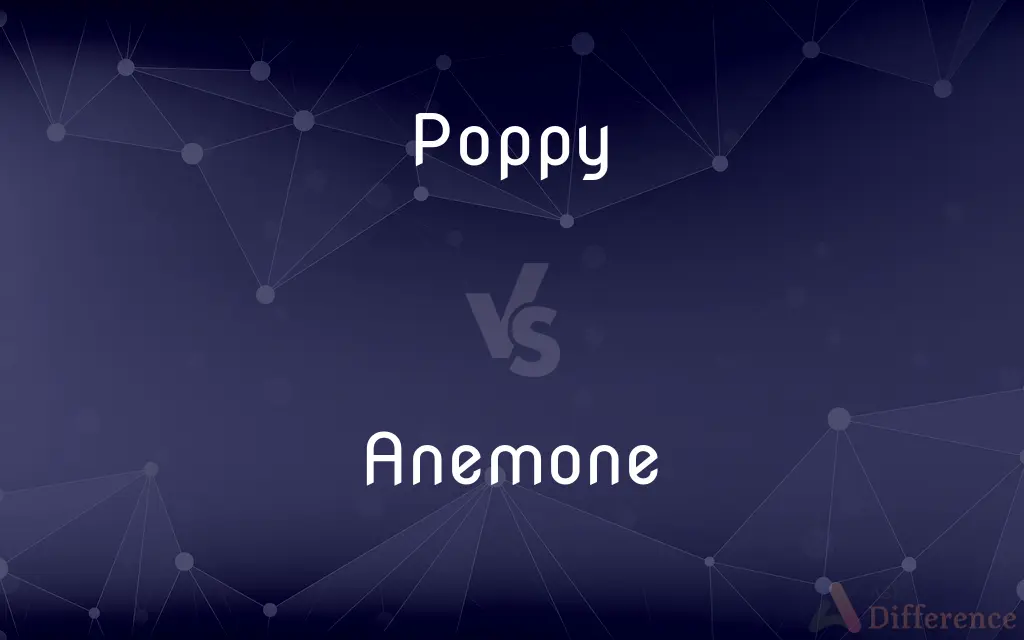Poppy vs. Anemone — What's the Difference?
By Urooj Arif & Fiza Rafique — Updated on April 23, 2024
Poppy and anemone are both flowering plants; poppies are known for their bold, solitary flowers and opioid seeds, whereas anemones feature delicate blossoms and are mainly ornamental.

Difference Between Poppy and Anemone
Table of Contents
ADVERTISEMENT
Key Differences
Poppies are distinctive for their colorful, cup-shaped flowers that often feature a single layer of petals around a dark center, making them standout in gardens and fields. Whereas anemones, also called "windflowers," generally have a softer appearance with multiple layers of fine, often pastel petals.
While poppies are cultivated both for their aesthetic appeal and their seeds, which are used in baking and can produce opium, anemones are primarily grown for their decorative value and do not have any narcotic properties. On the other hand, anemones have no association with narcotics and are prized for their ability to flourish in shady conditions.
Poppies thrive in full sunlight and are found in a variety of climates, ranging from temperate to subtropical regions. Conversely, anemones prefer partial shade and are often found in woodland settings or rock gardens, highlighting their versatility in less sunny landscapes.
The lifecycle of a poppy includes a phase where the plant lies dormant as a seed, capable of surviving harsh conditions before blooming beautifully. Anemones, on the other hand, often propagate through their root system, which allows them to spread and cover ground effectively.
Comparison Chart
Flower Structure
Solitary, bold flowers with few petals
Delicate, often multi-petaled blossoms
ADVERTISEMENT
Growing Conditions
Prefers full sun
Thrives in partial shade
Uses
Ornamental, culinary seeds, narcotic
Primarily ornamental
Propagation
Seed-based, often dormant
Often spreads through roots
Cultural Significance
Symbol of remembrance, especially in war
Associated with myths and ancient cultures
Compare with Definitions
Poppy
Hardy and resilient in various climates.
Despite harsh conditions, poppies thrive beautifully.
Anemone
A perennial with delicate flowers, often in gardens.
Anemones bloom beautifully under my oak tree.
Poppy
A flowering plant with a single flower per stem.
The red poppy is a common sight in European fields.
Anemone
Requires partial shade or filtered sunlight.
Anemones are ideal for shaded garden spots.
Poppy
Grows well in disturbed soils.
Poppies often sprout in fields that have been recently plowed.
Anemone
Associated with wind due to their responsive blossoms.
Anemones sway gently with every breeze.
Poppy
Known for seeds that are used in baking and for opium.
Poppy seeds are popular in pastries for their texture and flavor.
Anemone
Comes in various species with diverse appearances.
The Japanese anemone features larger, pink flowers.
Poppy
Symbol of remembrance and sleep.
Poppies are worn on Remembrance Day to honor fallen soldiers.
Anemone
Spreads through rhizomes or tubers.
The anemone patch has expanded each year through natural propagation.
Poppy
A poppy is a flowering plant in the subfamily Papaveroideae of the family Papaveraceae. Poppies are herbaceous plants, often grown for their colourful flowers.
Anemone
Anemone () is a genus of flowering plants in the buttercup family Ranunculaceae. Plants of the genus are commonly called windflowers.
Poppy
A herbaceous plant with showy flowers, milky sap, and rounded seed capsules. Many poppies contain alkaloids and are a source of drugs such as morphine and codeine.
Anemone
Any of various perennial herbs of the genus Anemone in the buttercup family, native chiefly to northern temperate regions and having palmately lobed leaves and large white or brightly colored flowers. Also called windflower.
Poppy
(of popular music) tuneful and immediately appealing
Catchy, poppy tunes
Anemone
A sea anemone.
Poppy
Any of various plants of the genus Papaver, having colorful flowers usually with four delicate petals, milky sap, and a capsule with pores that release numerous small seeds.
Anemone
Any plant of the genus Anemone, of the Ranunculaceae (or buttercup) family, such as the windflower.
Poppy
Any of various other plants of the family Papaveraceae, such as the California poppy.
Anemone
A sea anemone.
Poppy
A vivid red to reddish orange.
Anemone
A genus of plants of the Ranunculus or Crowfoot family; windflower. Some of the species are cultivated in gardens.
Poppy
Any plant of the genus Papaver or the family Papaveraceae, with crumpled, often red, petals and a milky juice having narcotic properties; especially the common poppy or corn poppy (Papaver rhoeas) which has orange-red flowers; the flower of such a plant.
Anemone
The sea anemone. See Actinia, and Sea anemone.
Poppy
A bright red colour tinted with orange, like that of the common poppy flower.
Anemone
Any woodland plant of the genus Anemone grown for its beautiful flowers and whorls of dissected leaves
Poppy
A simple artificial poppy flower worn in a buttonhole or displayed in other contexts to remember those who died in the two World Wars and other armed conflicts, especially around Remembrance Day/Remembrance Sunday.
Anemone
Marine polyps that resemble flowers but have oral rings of tentacles; differ from corals in forming no hard skeleton
Poppy
(endearing) One's father or grandfather, or a male authority figure having similar standing.
Poppy
Of a bright red colour tinted with orange, like that of the common poppy flower (Papaver rhoeas).
Poppy
Having a popping or bursting sound.
Poppy
Of a beverage: resembling soda pop; effervescent, fizzy.
Poppy
Of eyes: protruding, sticking out.
Poppy
(dated) Popular.
Poppy
(music) Typical, or in the style, of pop music.
Poppy
Any plant or species of the genus Papaver, herbs with showy polypetalous flowers and a milky juice. From one species (Papaver somniferum) opium is obtained, though all the species contain it to some extent; also, a flower of the plant. See Illust. of Capsule.
Poppy
A raised ornament frequently having the form of a final. It is generally used on the tops of the upright ends or elbows which terminate seats, etc., in Gothic churches.
Poppy
Annual or biennial or perennial herbs having showy flowers
Common Curiosities
What is an anemone?
An anemone is a perennial plant known for its delicate flowers and ability to thrive in shady environments.
How are poppies and anemones different in appearance?
Poppies have bold, usually solitary flowers with a few petals, while anemones have softer, often multi-petaled blossoms.
Can both poppies and anemones be used for landscaping?
Yes, both are popular in landscaping; poppies for sunny spots and anemones for shaded areas.
What is a poppy?
A poppy is a flowering plant known for its bold flowers and seed pods that are used in both culinary and medicinal contexts.
Are poppies and anemones easy to grow?
Poppies are generally easy to grow from seeds in a variety of soils, whereas anemones might require more specific conditions like partial shade and well-drained soil.
What type of maintenance do poppies and anemones require?
Poppies require minimal maintenance and thrive in full sun, while anemones need protection from intense sunlight and may need division to manage growth.
Do anemones have any medicinal uses?
Anemones do not have notable medicinal uses like some poppies, which are used to produce opium.
How do poppies and anemones propagate?
Poppies propagate through seeds, often lying dormant until conditions are right, while anemones spread through their root systems.
Can anemones be grown indoors?
Anemones can be grown indoors if they receive sufficient light and are cared for properly in terms of soil moisture and temperature.
What soil conditions favor poppies and anemones?
Poppies are versatile and can tolerate various soils, while anemones prefer well-drained, fertile soil.
What are the cultural significances of poppies?
Poppies are a symbol of remembrance for fallen soldiers, especially in Commonwealth countries.
Are there any risks in growing poppies?
Some poppies can be invasive, and those containing opium are regulated in many countries.
Which is more suitable for a rock garden, poppies or anemones?
Anemones, with their preference for partial shade and ability to spread, are well-suited for rock gardens.
What climates are best for growing poppies and anemones?
Poppies can grow in a range of climates from temperate to subtropical, while anemones prefer temperate climates with cooler, shaded areas.
What is the blooming season for poppies and anemones?
Poppies typically bloom in late spring or early summer, while anemones may bloom from early spring to fall, depending on the species.
Share Your Discovery

Previous Comparison
Amylase vs. Pepsin
Next Comparison
Teppanyaki vs. GriddleAuthor Spotlight
Written by
Urooj ArifUrooj is a skilled content writer at Ask Difference, known for her exceptional ability to simplify complex topics into engaging and informative content. With a passion for research and a flair for clear, concise writing, she consistently delivers articles that resonate with our diverse audience.
Co-written by
Fiza RafiqueFiza Rafique is a skilled content writer at AskDifference.com, where she meticulously refines and enhances written pieces. Drawing from her vast editorial expertise, Fiza ensures clarity, accuracy, and precision in every article. Passionate about language, she continually seeks to elevate the quality of content for readers worldwide.
















































